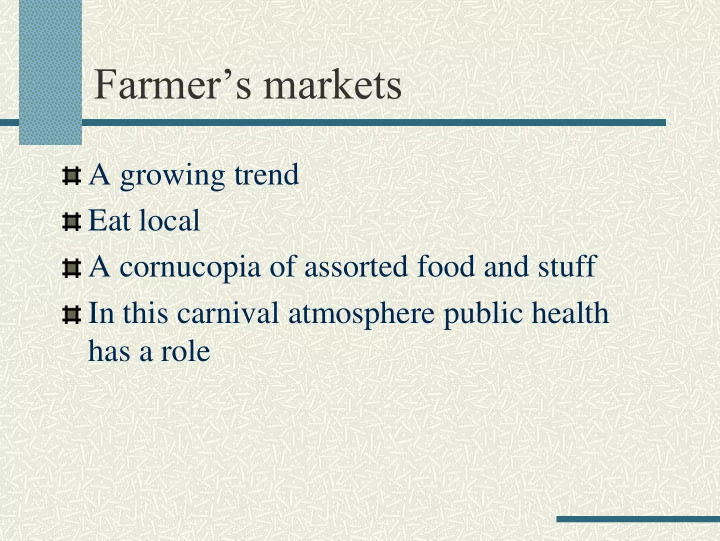

Farmer’s markets A growing trend Eat local A cornucopia of assorted food and stuff In this carnival atmosphere public health has a role
Selling at the Farmers Market Raw agricultural products This includes products such as Whole uncut fruits and vegetables Whole uncut melons Nuts in the shell Non-potentially hazardous, packaged foods from an approved, inspected source Potentially hazardous foods if allowed by local code
Selling at the Farmers Market Protection from contamination such as rain, dirt, pests, and chemicals can be accomplished by: Overhead protection (canopy) Food stored up off of the ground Food items separated from chemicals such as pesticides or gasoline
Produce Stand vs. Food Establishment Produce Stand Food Establishment Not a food Regulated and establishment inspected Sales limited to uncut, Capable of selling raw agricultural potentially hazardous products foods Sell pre-packaged Sale of unpackaged non-potentially ready to eat foods hazardous foods Food preparation
Fruits and vegetables The beginning Good agricultural practices No samples – no problem Samples = processing
Samples Must be dispensed in appropriate manner All food items much be washed Samples that are PHF’s must have time or temperature control.
Meat - beef, pork, etc. USDA – MDA inspected and stamped Stamped – not for sale- not to be sold Typically held frozen
Poultry – rabbits Fewer than 1000 processed/year – exempt from facility inspection No adulteration of product Held at appropriate temperatures
Wild game No road kill – canned possum stew If sold must be raised specifically for consumption and inspected by USDA/MDA Unadulterated Proper temperature
Dairy No raw milk/cream Yogurt, butter, sour cream, cheese, etc. – must be produced in licensed facilities regulated by milk board Packaging must be intact and held at proper temperature
Eggs Must have retailer’s and dealer’s license Eggs should appear clean Held at proper temperature Cartons labeled with name and address
Manufactured foods Jams, jellies,honey -considered low risk - home kitchens ok if under $30K/year -sold directly to consumer -label with common name/ingredients -placard-not inspected by health dept. -low sugar/sugar free-not low risk
Baked goods Home Kitchens/No Inspection Ok Sold directly to consumer Labeling with ingredients/mfg info Placarding – not inspected by Health Dept.
Acidified foods Pickles, salsas, sauces, etc. Highly regulated Labeling is tightly controlled Mfg. facility will be inspected Product ph below 4.5 is key
Live animals Kept at least 50 foot from product sales Transporting chickens and cookies Butchering on-site – not there yet
Food stands Hot and cold running water Protected from environmental conditions Hand wash Sanitary water disposal Wash/rinse/sanitize toilet
Selling at the Farmers Market If potentially hazardous foods are sold: Proper handling/controls in place for potentially hazardous foods Temperature controls need to be put in place Proper personal hygienic practices must be followed Proper cleaning, sanitization of utensils, surfaces Food protection from environmental contaminants
What About Hand Washing? Hand washing is required when open food preparation occurs Hand washing facilities must include running water, soap and single use towels Hand washing should be done after using the restroom and prior to handling food items Hand washing is the best defense for pathogens such as Hepatitis A
Wash-Rinse-Sanitize Utensils and equipment need to be cleaned and sanitized properly to avoid the spread of harmful pathogenic bacteria A 3 step process is the most often used method Washing removes debris Rinsing removes the soap Sanitizing reduces harmful organisms by 99.99%
Selling at the Farmers Market Processed Food must be from an approved source Jerky, or products containing beef, pork or poultry must be approved by the USDA (785) 841-5600 Foods such as salsa, relish, pickles, BBQ sauce, must come from an approved, inspected kitchen
From an Inspected, Approved Source?
What is an Inspected Approved Source? A facility that is routinely inspected e.g., Local Public Health Agency (LPHA), United States Department of Agriculture (USDA) or Food & Drug Administration (FDA) or Missouri Department of Health & Senior Services (DHSS) The kitchen will be separate from the residence Hot and cold holding equipment Plumbing fixtures, good repair, no cross-connections Safe water and sewer properly functioning Employees knowledgeable to safe food handling practices
Food Identity Proper labeling helps the consumer make informed decisions Package labeling should include Product name Manufacturer’s name and address List of ingredients in descending order of predominance Net Weight (in metric and english units)
Who does What? LPHA is responsible for inspection, regulation of food establishments Some have their own ordinance for food Local ordinance (county or city) may be more restrictive, i.e. permits may be required or types of foods sold may be limited
Let’s Wrap it Up What can be sold at a produce stand Produce stand or food establishment Food establishment requirements Where can foods be prepared Proper food storage and safety Permitting and inspections
Recommend
More recommend